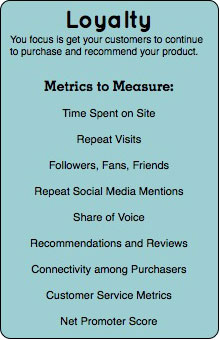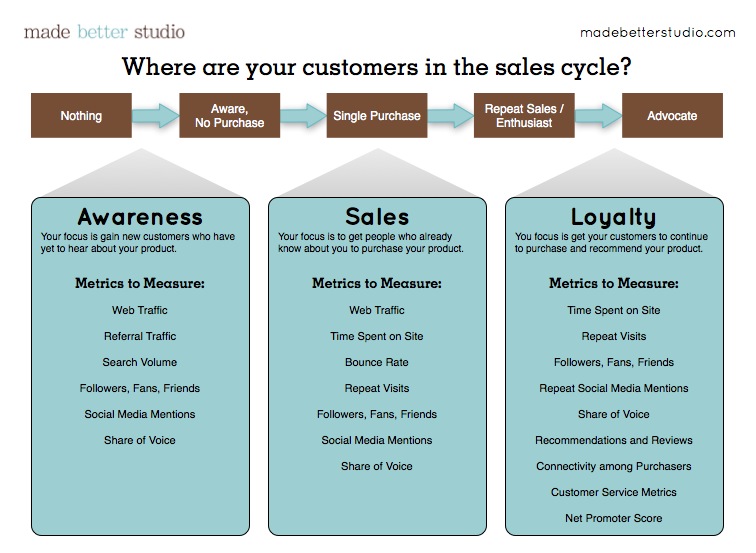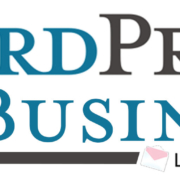One of the most overlooked and yet VERY important parts of marketing is measuring the Return on Investment (ROI) by tracking meaningful metrics based on the type of interaction you’re looking for from your customers.
Somehow, even with all the hype around ROI, when I ask new clients if they’re tracking metrics, they give pause and a blank face. So, it’s time I share a little post and create a little infosheet on how to choose and measure metrics that matter around your marketing.
What interaction are you looking for?
Return on Investment starts with what interaction you’re looking for. What are you looking for with these new found client interactions?
Usually this answer boils down to three main categories of interaction:
- Awareness: You want someone to pay attention to what you have to offer.
- Sales: You want someone to buy what you have to offer. (This requires awareness.)
- Loyalty: You want someone to share what you have to offer. (This requires awareness and sales or a really close relationship.)
Notice how they kind of build upon themselves.
When a person is introduced to your product and your company they start off in awareness phase, where they learn of you, learn more about you and might even begin to trust you.
Then all the sudden one day they may need what you have, and this pushes them over into the sales phase where they evaluate your solution, further building trust in you and then something miraculous happens… they buy from you.
Based on this new experience, they may further trust in you and their additional experience of using your product, coming into the loyalty phase which builds into actions such as repeat buying, recommending to friends, etc.
Each of these phases come with their own set of online/offline metrics to measure to really support if what you’re doing marketing-wise is really properly introducing people along through these steps of becoming a loyal customer.
So based on what interactions you want to have with customers, you select the metrics to measure based on those kinds of interactions.
Awareness: The Metrics to Measure
So for awareness, select from the following metrics to measure…
 Web Traffic is the amount of website visitors your website receives over a given time, usually daily or monthly. You can easily track this metric using a web analytics tracker such as Google Analytics (which is FREE by the way).
Web Traffic is the amount of website visitors your website receives over a given time, usually daily or monthly. You can easily track this metric using a web analytics tracker such as Google Analytics (which is FREE by the way).
This number is important, since over 97% of people use online resources in some way or another to shop. (BIA/Kelsey March 2010) So even if someone is just finding out about (where awareness begins) your website traffic numbers will tell you if you’re getting more or less interested people to your information.
Referral Traffic is the amount of website traffic you receive from other places around the web (know as referrals) and this can also be tracked with Google Analytics. Referral traffic is great to track for awareness because people learn about and trust new products usually through referral sources.
Search Volume is how much of your web traffic is coming from search engines. Search engines are important due to the fact that when consumers are asked where an online product research process usually starts, more than four in 10 (44%) start with a search engine and look for top search results relating to the product they desire. (e-tailing group and PowerReviews June 2011)
Followers, Fans and Friends are all social web numbers, the number of followers on Twitter, fans on Facebook and friends on other social networking websites is a good way to track new social connections that might be new possible customers trying to get the scoop on your company, services or products. 51% of consumers use social media in some way to come up with shopping ideas. (e-tailing group and PowerReviews June 2011)
Social Media Mentions is a count of the number of times you were mentioned on social media and perhaps even if the comment was positive or negative (known as sentiment). Mentions are great to track, because you can consider anyone who saw that social mention as now aware of who you are. Social mentions can be searched for and even alerted to by using a free tool called Social Mention.
Share of Voice is a review of how many times you were mentioned on social channels vs. a competitor and sentiment of that discussion. This can be tracked by finding the social mentions and their sentiment of not only you, but of your competitors as well.
Sales: The Metrics to Measure
For sales, select from the following metrics to measure…
 Web Traffic is the amount of website visitors your website receives over a given time, usually daily or monthly. You can easily track this metric using a web analytics tracker such as Google Analytics (which is FREE by the way).
Web Traffic is the amount of website visitors your website receives over a given time, usually daily or monthly. You can easily track this metric using a web analytics tracker such as Google Analytics (which is FREE by the way).
Time Spent on Site is the amount of time a user is spending on your website. The longer they spend on you website, the higher the chances are that they’re interested and are looking for more information. This metric can be tracked by Google Analytics as well.
Bounce Rate is the percentage of visitors who enter the site and “bounce” (leave the site) rather than continue viewing other pages within the same site. In other words, you really don’t have what they’re looking for, and they’re off to find it somewhere else. This metric can be tracked by Google Analytics as well.
Repeat Visits are the amount of visitors that come back to your website a second or third time, which is a trend among research buyers to visit multiple times before making a purchase or decision to purchase. This metric can be tracked by Google Analytics as well.
Followers, Fans and Friends are all social web numbers, the number of followers on Twitter, fans on Facebook and friends on other social networking websites is a good way to track new social connections that might be new possible customers trying to get the scoop on your company, services or products. 51% of consumers use social media in some way to come up with shopping ideas. (e-tailing group and PowerReviews June 2011)
Social Media Mentions is a count of the number of times you were mentioned on social media and perhaps even if the comment was positive or negative (known as sentiment). Mentions are great to track, because you can consider anyone who saw that social mention as now aware of who you are. Social mentions can be searched for and even alerted to by using a free tool called Social Mention.
Share of Voice is a review of how many times you were mentioned on social channels vs. a competitor and sentiment of that discussion. This can be tracked by finding the social mentions and their sentiment of not only you, but of your competitors as well.
Loyalty: The Metrics to Measure
For loyalty, select from the following metrics to measure…
 Time Spent on Site is the amount of time a user is spending on your website. The longer they spend on you website, the higher the chances are that they’re a loyal interested customer looking for and spending a good deal of time with information on your website. You can easily track this metric using a web analytics tracker such as Google Analytics (which is FREE by the way).
Time Spent on Site is the amount of time a user is spending on your website. The longer they spend on you website, the higher the chances are that they’re a loyal interested customer looking for and spending a good deal of time with information on your website. You can easily track this metric using a web analytics tracker such as Google Analytics (which is FREE by the way).
Repeat Visits are the amount of visitors that come back to your website a second or third time. This metric is important to loyalty to track how often a visitor returns to your website for more information. This metric can be tracked by Google Analytics as well.
Followers, Fans and Friends are all social web numbers, the number of followers on Twitter, fans on Facebook and friends on other social networking websites is a good way to track new social connections that might be new possible customers trying to get the scoop on your company, services or products. 51% of consumers use social media in some way to come up with shopping ideas. (e-tailing group and PowerReviews June 2011)
Repeat Social Media Mentions is a count of the number of times you were mentioned on social media by the same person, if they’re talking about you all the time, chances are they’re a super fan and can be considered in the loyal flock.
Share of Voice is a review of how many times you were mentioned on social channels vs. a competitor and sentiment of that discussion. This can be tracked by finding the social mentions and their sentiment of not only you, but of your competitors as well.
Recommendations and Reviews are great metrics to track since lots of people use recommendations and reviews (known or unknown) every day to make purchasing decisions. In fact, 90% of consumers online trust recommendations from people they know; 70% trust opinions of unknown users. (Econsultancy, July 2009)
Connectivity among Purchasers is a measure of how connected your purchasers are. To gain this insight check out klout.com on some of your more active loyal fans to see how connected they are to other people that you’d be interested in talking to.
Customer Service Metrics are metrics based around how happy your customers are when they interact with you. Customer happiness is a direct correlator to how interested they’ll be in recommending your services later.
Net Promoter Score is simply a polled question of your past customers to see how likely they are to recommend your product or service to someone else in the future.
Download Infosheet
I’ve consolidated this data into a wonderful little info sheet you can keep around the office to help remind you to check in on your metrics and REALLY see how your marketing is doing.









 April Holle, Principal of Made Better Studio
April Holle, Principal of Made Better Studio
This is very helpful information. I can’t wait to learn more.